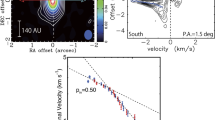Abstract
Rotation curves of our Galaxy, M31 and M81 have a deep minimum atR=1–4 kpc. It is demonstrated that this minimum can be dynamically explained if the stellar disks of these galaxies have no representatives in the central region. Such a ring-like distribution of matter in stellar disks is suggested by the similarity observed in the distribution of extreme Population I objects if we assume that a stellar disk was formed from a gaseous disk which always had a ring-like structure.
The presence of central holes in disks of spiral galaxies suggests that during the initial collapse phase almost all protogalactic gas with a low angular momentum has been consumed to form the spheroidal component. No low-momentum gas was left over to form central parts of stellar disks.
Similar content being viewed by others
References
Barabanov, A. V. and Zasov, A. V.: 1979,Astron. Zh. 56, 252.
Berkhuijsen, E. M.: 1977,Astron. Astrophys. 57, 9.
Berman, R. H. and Mark, J. W.-K.: 1979,Astron. Astrophys. 77, 31.
Brandt, I. C., Kalinowski, I. K. and Roosen, R. G.: 1972,Astrophys. J. Suppl. Ser. 24, 241.
Connolly, L. P., Mantarakis, P. Z. and Thompson, L. A.: 1972,Publ. Astron. Soc. Pacific. 84, 61.
Deharveng, I. M. and Pellet, A.: 1975,Astron. Astrophys. 38, 15.
de Vaucouleurs, G.: 1948,Ann. d'Astrophys. 11, 247.
de Vaucouleurs, G.: 1953,Monthly Notices Roy. Astron. Soc. 113, 134.
de Vaucouleurs, G.: 1958,Astrophys. J. 128, 465.
Eggen, O. J., Lynden-Bell, D. and Sandage, A. R.: 1962,Astrophys. J. 136, 748.
Einasto, J.: 1969,Astrofiz. 5, 137.
Einasto, J. and Einasto, L.: 1972,Tartu Astron. Obs. Teated, No. 36, 3.
Einasto, J., Jôeveer, M. and Kaasik, A.: 1976,Tartu Astron. Obs. Teated, No. 54, 3.
Einasto, J., Haud, U., Jôeveer, M., Kaasik, A. and Traat, P.: 1978,Astron. Circ., No. 1023.
Einasto, J., Tenjes, P. and Traat, P.: 1979b,Astron. Circ. (in press).
Emerson, D. T.: 1976,Monthly Notices Roy. Astron. Soc. 181, 537.
Georgelin, Y. M.: 1975, Thesis.
Goad, J. M.: 1976,Astrophys. J. Suppl. Ser. 32, 89.
Gordon, M. A. and Burton, W. B.: 1976,Astrophys. J. 208, 346.
Guibert, J., Lequeux, I. and Viallefond, F.: 1978,Astron. Astrophys. 68, 1.
Haud, U.: 1979,Pis'ma v Astron. Zh. 5, 124.
Jackson, P. D., FitzGerald, M. P. and Moffat, A. F. J.: 1978, in W. B. Burton (ed.), ‘The Large-Scale Characteristics of the Galaxy’,IAU Symp. 84, 221.
Kormendy, J.: 1977,Astrophys. J. 217, 406.
Light, E. S., Danielson, R. E. and Schwarzschild, M.: 1974,Astrophys. J. 194, 257.
Newton, K. and Emerson, D. T.: 1977,Monthly Notices Roy. Astron. Soc. 181, 537.
Pellet, A.: 1976,Astron. Astrophys. 50, 412.
Rots, A. H.: 1975,Astron. Astrophys. 45, 43.
Rots, A. H. and Shane, W. W.: 1975,Astron. Astrophys. 45, 25.
Rubin, V. C. and Ford, W. K. Jr.: 1970,Astrophys. J. 159, 379.
Rubin, V. C., Ford, W. K. Jr. and Thonnard, N.: 1978,Astrophys. J. 225, L107.
Sandage, A. R., Becklin, E. E. and Neugebauer, G.: 1969,Astrophys. J. 157, 55.
Sandage, A. R., Freeman, K. C. and Stokes, N. R.: 1970,Astrophys. J. 160, 831.
Schweizer, F.: 1976,Astrophys. J. Suppl. Ser. 31, 323.
van den Bergh, S.: 1964,Astrophys. J. Suppl. 9, 65.
van Houten, C. J.: 1961,BAN 16, 1.
Visser, H. C. D.: 1978,The Dynamics of the Spiral Galaxy M81, Gröningen.
Zasov, A. V.: 1976,Astron. Circ., No. 933, 1.
Author information
Authors and Affiliations
Rights and permissions
About this article
Cite this article
Einasto, J., Tenjes, P., Barabanov, A.V. et al. Central holes in disks of spiral galaxies. Astrophys Space Sci 67, 31–43 (1980). https://doi.org/10.1007/BF00651866
Received:
Issue Date:
DOI: https://doi.org/10.1007/BF00651866




